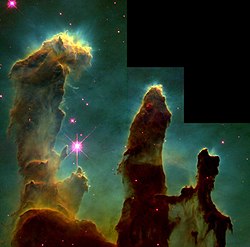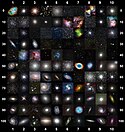Pillars of creation 2014 HST WFC3-UVIS full-res denoised
Astronomers combined several Hubble exposures to assemble the wider view. The towering pillars are about 5 light-years tall. The dark, finger-like feature at bottom right may be a smaller version of the giant pillars. The new image was taken with Hubble's versatile and sharp-eyed Wide Field Camera 3.
The pillars are bathed in the blistering ultraviolet light from a grouping of young, massive stars located off the top of the image. Streamers of gas can be seen bleeding off the pillars as the intense radiation heats and evaporates it into space. Denser regions of the pillars are shadowing material beneath them from the powerful radiation. Stars are being born deep inside the pillars, which are made of cold hydrogen gas laced with dust. The pillars are part of a small region of the Eagle Nebula, a vast star-forming region 6,500 light-years from Earth.
The colors in the image highlight emission from several chemical elements. Oxygen emission is blue, sulfur is orange, and hydrogen and nitrogen are green.
A number of Herbig-Haro jets lengthened noticeably (see lower panel of linked page) in the nearly 20-year interval between the two Hubble images.
Object Names: M16, Eagle Nebula, NGC 6611
A longer news release is linked here.
The original image was edited to reduce noise.Relevante Bilder
Relevante Artikel
Säulen der SchöpfungSäulen der Schöpfung ist der Name einer Formation, die mit dem Hubble-Weltraumteleskop im etwa 7000 Lichtjahre entfernten Adlernebel fotografiert wurde. Das Bild wurde am 1. April 1995 aufgenommen, die verantwortlichen Astronomen waren Jeff Hester und Paul Scowen von der Arizona State University. .. weiterlesen
AdlernebelDer Adlernebel oder IC 4703 ist ein Nebel in Verbindung mit einem offenen Sternhaufen. Der offene Sternhaufen trägt im Messier-Katalog die Bezeichnung M16 bzw. im NGC die Nummer NGC 6611. In vielen Katalogen werden Nebel und Sternhaufen gleichbedeutend aufgeführt, so dass die Messier-Katalog-Bezeichnung meist auch für den Nebel verwendet wird. Er befindet sich im Sternbild Schlange bei den Koordinaten 18h19m (Rektaszension) und −13°47' (Deklination). .. weiterlesen








